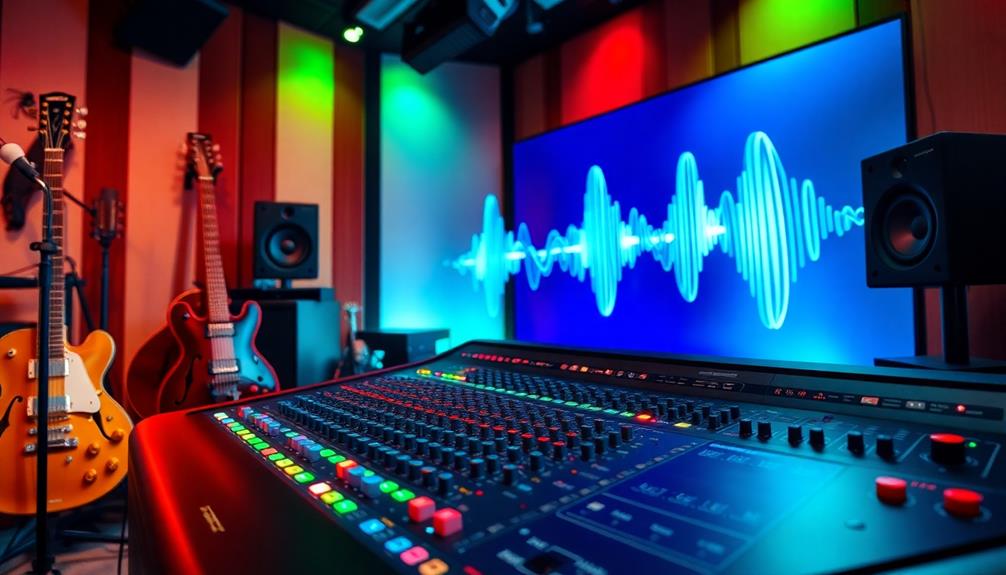Layering vocals is key to achieving a richer sound in your music. You can start by double-tracking your lead vocals, which adds thickness. Consider recording harmonies a third or fifth above the lead for depth, and don't forget about background vocals to enhance texture. Use various effects on different layers to keep things fresh. Be mindful of mixing levels to maintain clarity; background vocals should sit lower than the lead. With these techniques, you'll create a dynamic mix that engages listeners. There's so much more to explore about effective layering techniques to elevate your sound even further.
Key Takeaways
- Vocal layering enhances sound richness by stacking multiple takes, creating a thicker and more engaging audio experience.
- Doubling and panning lead vocals can create a fuller stereo image, enriching the overall mix.
- Incorporating harmony vocals recorded a third or fifth above the lead adds emotional depth and complexity.
- Utilizing unique processing settings for each vocal layer prevents monotony and promotes a more engaging listening experience.
- Regularly assessing mixes helps maintain clarity by avoiding mud and ensuring a balanced dynamic between lead and background vocals.
Understanding Vocal Layering
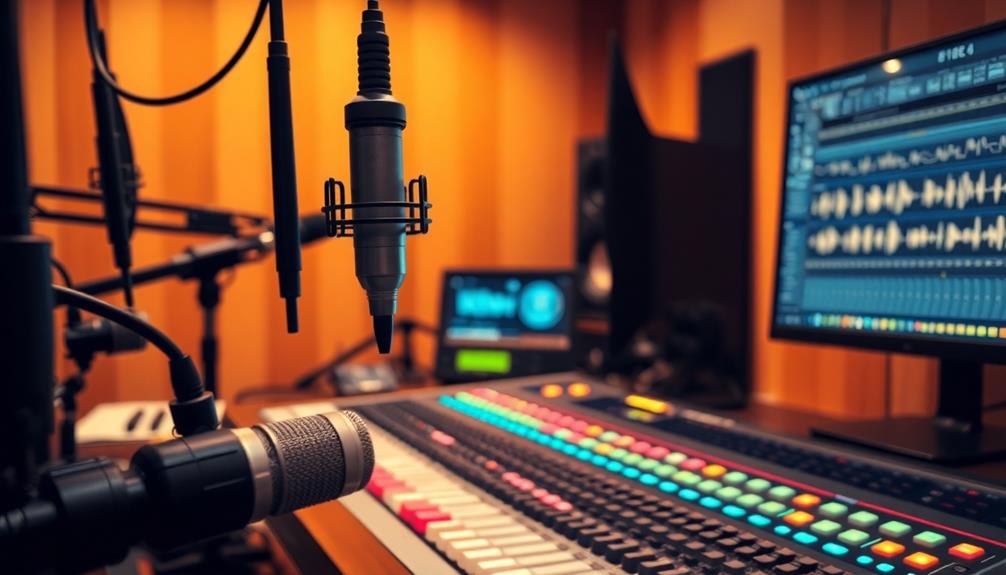
When you immerse yourself in vocal layering, you're opening up a world of possibilities for enhancing your music. Vocal layering techniques allow you to stack multiple recorded vocal takes, enriching the texture of your lead vocal track.
The simplest approach is double tracking, where you record a second take of the same line to thicken your original performance. But why stop there? Modern production often involves tripling or quadrupling vocal tracks, giving your mix greater depth.
To elevate your vocal layering game, consider incorporating techniques used for audio editing in Ableton Live to achieve cleaner mixes and enhance your workflow.
You can employ different types of layers, like background vocals and harmonies underneath, to support the lead vocal and elevate the emotional impact of your song. Layering vocals can create stunning vocal harmonies that captivate listeners.
Experimenting with unique effects on each layer can also add a fresh twist to your sound.
Mastering these vocal layering techniques can greatly enhance production quality, pushing your creative boundaries. You'll discover how to effectively layer vocals to create a fuller, richer sound that resonates with your audience.
Techniques for Effective Layering
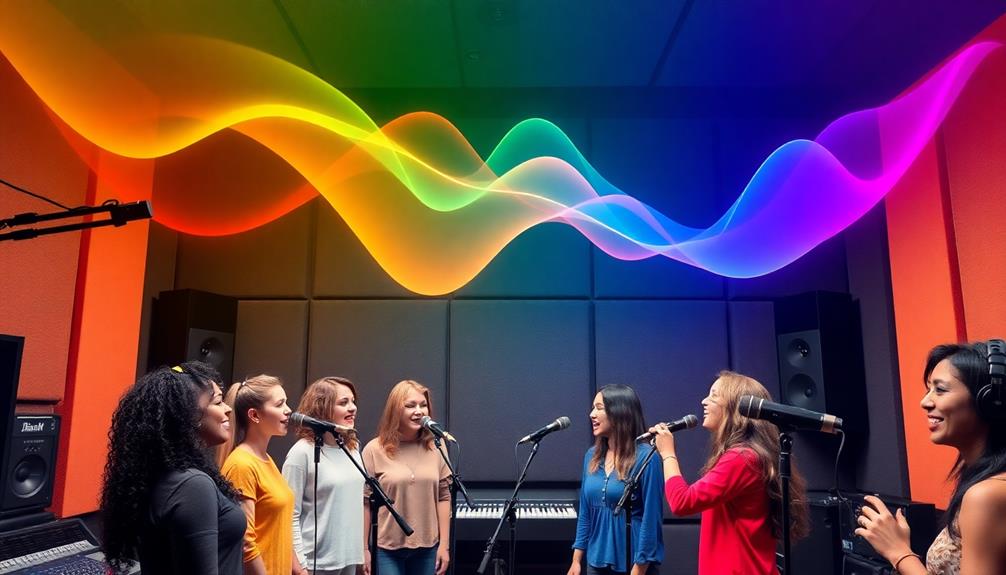
Effective layering techniques can transform your vocal tracks from ordinary to extraordinary, delivering a polished and engaging sound. Start by doubling your lead vocals; record them twice and pan each take left and right. This creates a fuller stereo image and enhances presence. Next, incorporate harmony vocals recorded a third or fifth above the lead. This enriches the sound while avoiding frequency overlap.
Here's a quick reference table for effective layering techniques:
| Technique | Description |
|---|---|
| Doubling | Record lead vocals twice, pan left and right. |
| Harmony Vocals | Record harmonies a third or fifth above lead. |
| Ad-libs | Add spontaneous vocals, hard-pan for texture. |
Don't forget to use pitch correction tools like Melodyne or Auto-Tune to guarantee perfect alignment of harmonies with your lead vocals. Finally, adjust volume levels carefully; background vocals should remain quieter than lead vocals to maintain clarity while providing depth. These techniques are essential for creating engaging and polished vocal tracks that captivate your audience.
Types of Vocal Layers

When you layer vocals, understanding the different types is essential for achieving that rich sound.
Start with your lead vocals, which need to shine through, then explore harmony layering strategies to add emotional depth.
Incorporating techniques from advanced mixing practices can further enhance your vocal layers.
Lead Vocal Techniques
Layering vocals is key to achieving a richer sound in your tracks, and understanding the different types of vocal layers can elevate your production. Here are some essential lead vocal techniques:
| Vocal Type | Description |
|---|---|
| Lead Vocals | The primary focus of your track, requiring clarity and presence to convey emotion. |
| Vocal Doubles | Layering identical takes of the lead vocals thickens the sound, enhanced by slight pitch shifting for a fuller effect. |
| Ad-libs | Spontaneous vocal elements that add energy, often featuring short phrases or melodic runs for dynamic contrast. |
In addition to these, harmony vocals can enhance lead vocals by adding complementary melodies a third or fifth above. Background vocals are vital for texture, providing depth while being mixed quieter to avoid frequency overlap. By employing these layering techniques, you can create a thickening sound that enriches your overall production. Remember, effective vocal recording is about blending these elements seamlessly to achieve that rich sound.
Harmony Layering Strategies
Harmony layering strategies can transform your vocal arrangements, adding depth and emotional resonance to your tracks. By incorporating additional vocal tracks that sing different pitches—typically a third or fifth above the lead vocal—you create a rich tapestry of sound.
It's essential to carefully record these layered harmonies to avoid frequency overlap with the lead vocal, ensuring they enhance rather than muddy the mix.
Utilizing unison tracks alongside harmonies can thicken the lead vocal while maintaining clarity. These tracks provide a cohesive sound when recorded tightly, making your main vocal performance stand out.
Consider using background vocals to support the lead with contrasting or complementary melodies; mix these at lower levels to keep the focus on the primary vocals.
Don't forget to incorporate ad-libs and improvised vocal elements. These can add energy and texture, providing dynamic variation throughout the song.
When you blend harmony layering with thoughtful arrangements of vocal tracks, you'll enhance the emotional depth of your music, inviting listeners into a more immersive experience.
Tools and Equipment for Layering
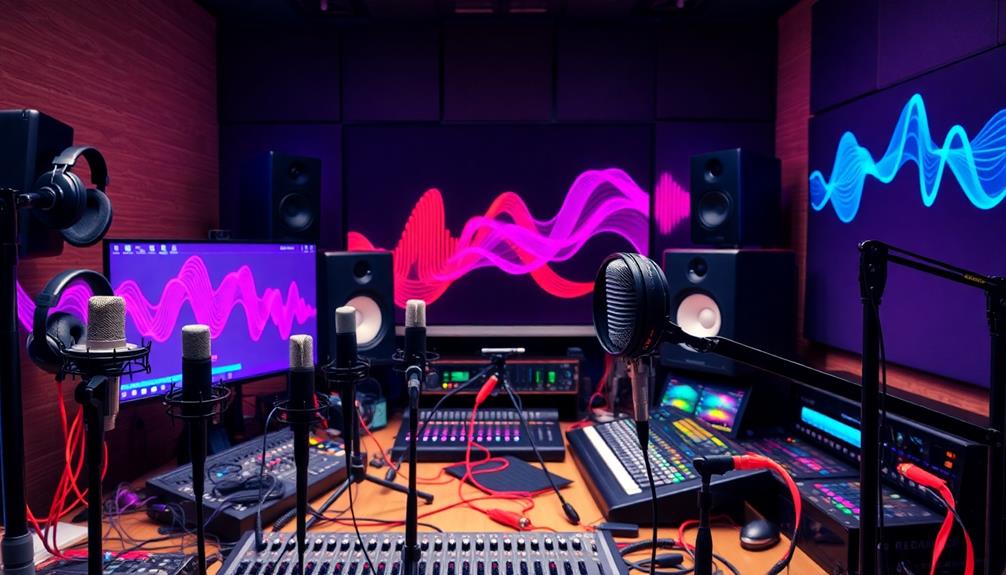
To achieve a richer vocal sound, investing in the right tools and equipment is vital. Start with high-quality microphones, like condenser mics, to capture clear and detailed vocal recordings. This clarity is essential when layering is a powerful technique, allowing you to build harmonies and create a lead double that stands out.
Additionally, incorporating Natural Language Processing (NLP) tools can enhance the interactive experience of your music production by providing real-time feedback during recording sessions.
Digital Audio Workstations (DAWs) such as Logic Pro and Ableton Live are indispensable for editing, mixing, and layering vocals efficiently. These platforms offer multi-track recording capabilities, enabling you to capture multiple vocal layers simultaneously and experiment with different arrangements.
Don't forget to enhance your layers with plugins for pitch correction like Melodyne or Auto-Tune. These tools guarantee that all vocal layers are harmonically aligned and polished. Additionally, reverb and delay plugins add depth and space to your layered vocals, helping to create a cohesive sound that enhances the overall mix.
With the right equipment and software, you can elevate your vocal layering to new heights, making your tracks resonate and engage listeners more effectively. Invest wisely, and watch your vocal sound transform!
Common Mistakes to Avoid
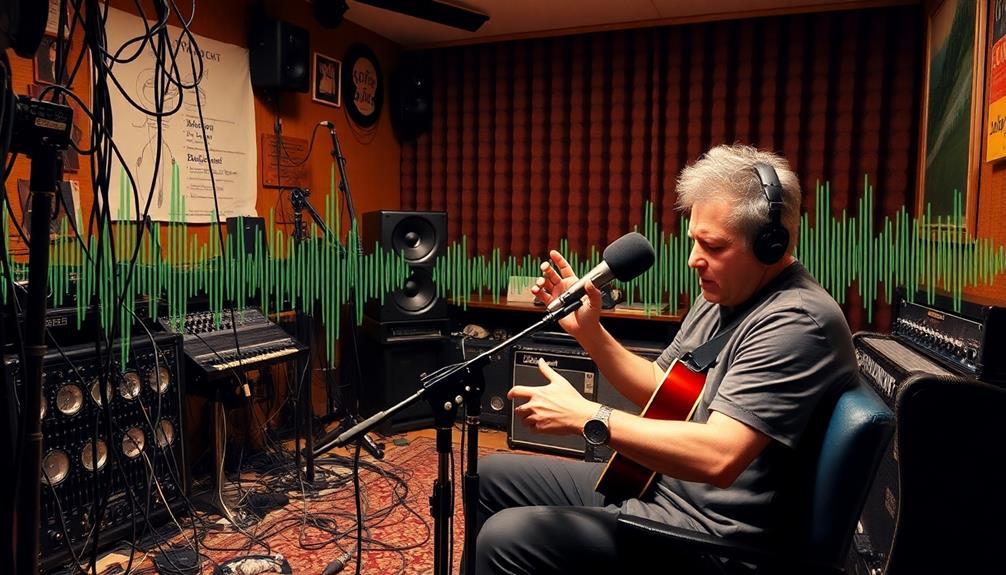
When layering vocals, it's easy to make a few common mistakes that can muddy your mix.
Overloading your track with too many layers, ignoring tuning issues, and neglecting dynamic balance can seriously compromise the clarity and impact of your sound.
Let's explore these pitfalls so you can create a richer, more polished vocal experience.
Overloading Vocal Layers
Overloading vocal layers can easily cloud your mix, creating a muddy sound that detracts from the clarity of your music. When too many overlapping frequencies collide, you risk phase issues that obscure your lead vocal. To avoid this, it's essential to balance vocal levels, ensuring that the primary melody shines through.
Regularly assess your mix and identify unnecessary layers; simplifying your arrangements can enhance the impact of key vocal elements instead of diluting them.
Aim for dynamic variation across your layers. Static or overly similar vocal tracks contribute to a flat sound that reduces listener engagement. Each layer should add something unique to the overall composition.
Additionally, steer clear of applying identical processing settings on all vocal layers. This can lead to a lack of depth and character, making your mix feel monotonous.
Ignoring Tuning Issues
Neglecting tuning issues in your vocal layers can seriously undermine the quality of your mix. If your vocals aren't pitch-perfect, you'll run into dissonance that detracts from the overall harmony of your track. This can create an unprofessional sound that distracts listeners.
To maintain clarity and cohesion in your mix, consider these steps:
- Utilize Vocal Tuning Software: Tools like Melodyne or Auto-Tune can help correct pitch discrepancies, ensuring your vocal layers blend seamlessly with the lead vocal.
- Regularly Check Tuning: During the mixing process, consistently assess the tuning of each layer. This habit prevents minor issues from becoming major distractions in your final product.
- Aim for Cohesion: Remember that even slight pitch variations can muddy your vocal sound. Work toward perfect harmony across all layers to enhance the overall mix.
Neglecting Dynamic Balance
In the mixing process, achieving dynamic balance among your vocal layers is essential for a polished final product. Neglecting this balance can overshadow your lead vocal, compromising the overall clarity of your track. When you overload the mix with too many vocal layers without managing their dynamics, you risk creating muddiness. This makes it hard for listeners to discern individual parts, ultimately diluting the emotional impact of your performance.
To maintain clarity, you need to carefully manage the volume levels of each vocal track. Important elements like harmonies and ad-libs should complement the lead vocal, not get lost in the mix. Using identical processing settings across all vocal layers can result in a flat sound; instead, vary the dynamics and effects tailored to each layer to enhance their presence.
Regularly assess your mix and utilize automation to dynamically adjust levels. This approach guarantees each part maintains its presence without overpowering the lead vocals, resulting in a more engaging mix.
Future Trends in Vocal Production

How will the future of vocal production reshape the music landscape? The integration of cutting-edge technology is setting the stage for a revolution in how we create and experience music. Here are three trends to watch:
- AI tools will streamline vocal synthesis, allowing for quicker layering and manipulation of vocal tracks, leading to innovative music creation.
- Virtual vocalists will give you the ability to experiment with melodies and harmonies without relying solely on human singers, making the creative process more efficient.
- Cloud-based collaboration will break down geographical barriers, enabling real-time teamwork among musicians and producers, enhancing the richness of emotional expression in your work.
As these technologies evolve, expect to see immersive experiences that engage listeners on a deeper level.
While AI-generated vocals will complement human performances, the trend will focus on authenticity and emotional resonance.
The future of vocal production isn't just about replacing voices; it's about enhancing the authenticity of performances and pushing the boundaries of creativity.
Embrace these trends, and you'll be well-equipped to craft the next generation of music that resonates with audiences everywhere.
Frequently Asked Questions
How Can I Sing With a Richer Voice?
To sing with a richer voice, focus on breath support, engage your diaphragm, and practice vocal techniques. Stay hydrated, do regular exercises, and consider working with a vocal coach for personalized guidance. You'll notice improvements!
How Do You Mix Vocals to Make Them Sound Fuller?
They say, "Good things come in threes." To mix vocals for fullness, record multiple takes, add harmonies, adjust levels, and experiment with effects. This way, you'll create a rich, engaging sound that captivates listeners.
What Is the Best Way to Stack Vocals?
To stack vocals effectively, record multiple takes, align them tightly, and experiment with panning. Incorporate harmonies and varying intensities, and apply different processing to each layer for clarity and dynamic contrast in your mix.
Should You Always Stack Vocals?
Think of stacking vocals like seasoning a dish; you don't always need more spice. Sometimes, simplicity shines. So, no, you shouldn't always stack vocals—consider the song's mood and arrangement before adding layers.
Conclusion
In the world of music, layering vocals is like painting a vibrant mural; each track adds depth and color to your sound. By mastering the techniques and avoiding common pitfalls, you can create a rich auditory landscape that captivates your listeners. As you experiment with different types of layers and tools, remember that the future of vocal production is as limitless as your creativity. So, don't hesitate to let your voice shine through the layers you create!



